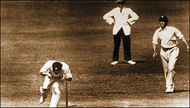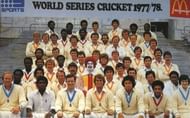There are quite a few fanatical cricket fans across the globe who can quote Sachin Tendulkar’s statistics (up to three decimal places if needed) in their sleep and recite bizarre cricket trivia with a flourish. Then there are those who religiously follow cricket but do not concern themselves with such facts and just enjoy the beauty of the game. This article intends to introduce this second breed of fans to some interesting facts about the sport that are not as widely known as S.Sreesanth’s dancing and sledging abilities.
#5. Why use wood if you can use aluminium?
On a bright day at Perth in the 1979 Ashes, Dennis Lillee nonchalantly walked out with an aluminium bat in his hand and calmly collected three runs. The England players complained that the bat was distorting the shape of the ball while Lillee’s own captain Ian Chappell was not happy with the whole idea and sent a wooden bat to Lillee. After a heated argument, Lillee obliged and thus ended the aluminium bat’s brief tryst with cricket.
What is significant is that prior to this incident, there were no laws specifying the material of the bat. The authorities woke up and promptly declared that bats were only to be made of wood from that point of time. What we can deduce from this incident is that brawny players like Chris Gayle, had they belonged to that era, could have easily used a bat made of steel to send the ball to orbit Mars.
#4. Canadians and Yankees came before, the Ashes later
Many people assume that the Lord’s cricket ground has been hosting international cricket ever since the Englishmen colonized half the world. What would surprise you is that the first ever international cricket match was played between U.S.A and Canada way back in 1844. Yes, the same teams that we occasionally see in World Cups and laugh derisively at.
What followed eventually as we all know is that the Americans found cricket too complicated for their liking and dumbed it down to baseball. The Canadians meanwhile found solace in ice hockey, apparently because there is no shortage of ice in Canada.
#3. Part with your wicket or your life
Don Bradman was a batting Terminator in the good old days and used to toy with the English bowlers with one arm tied behind his back. The England captain, Douglas Jardine wanted to change this somehow and struck upon an innovative yet controversial method. The “fast leg theory” entailed that the batsman was to be continuously bombarded with bouncers on his leg side. Almost all the fielders were also positioned in catching positions on the leg side.
What this meant was that the batsmen could either try to hook the ball or else get hit on the body in an era without helmets. This ploy won England the Ashes but it triggered a political furore between the two nations, and the laws of the game were modified to disallow negative bowling. The 1932-33 Ashes series was forever rechristened as the Bodyline series.
#2. I’m sorry but you are a bit late, Sir….
The least known, but a totally valid form of dismissal in cricket is a batsman being timed-out. A batsman has no more than three minutes to arrive at the crease and take guard, failing which the fielding side can appeal. This stipulated time is just 90 seconds in T-20 cricket, which explains the innovation of dug-outs.
While totally legal, dismissing a batsman in this manner is considered very unethical and hence there have been only four such recorded cases, all in first-class cricket. I feel that teams could have used this rule very effectively against Inzamam-ul-Haq, sportsmanship be damned.
#1. A rebel league that changed cricket
Kerry Packer was an Australian media mogul who wanted his Channel Nine to broadcast all cricket involving Australia. The Australian cricket board was not particularly keen on the idea and politely declined. Packer simply dug into his deep wallet and signed a majority of the top international players to create his own cricket league called the World Series Cricket in 1977. While it received a lukewarm response at first, the public gradually lapped it up to such an extent that the ACB relented and meekly surrendered the television rights to Channel Nine.
The WSC changed the face of the game in a way that even the IPL has not been capable of achieving. It introduced coloured clothing, day-night matches and the use of helmets to cricket. The players, who used to receive nominal match fees prior to WSC, were now paid handsomely by their respective cricket boards. Most importantly, the league married cricket to commerce and the game evolved into the entertainment extravaganza it is today.
There will be cricket fans who knew all these facts before reading this article. To the rest, I simply say that you are now one step closer to joining this elite group.
Brand-new app in a brand-new avatar! Download CricRocket for fast cricket scores, rocket flicks, super notifications and much more! 🚀☄️




